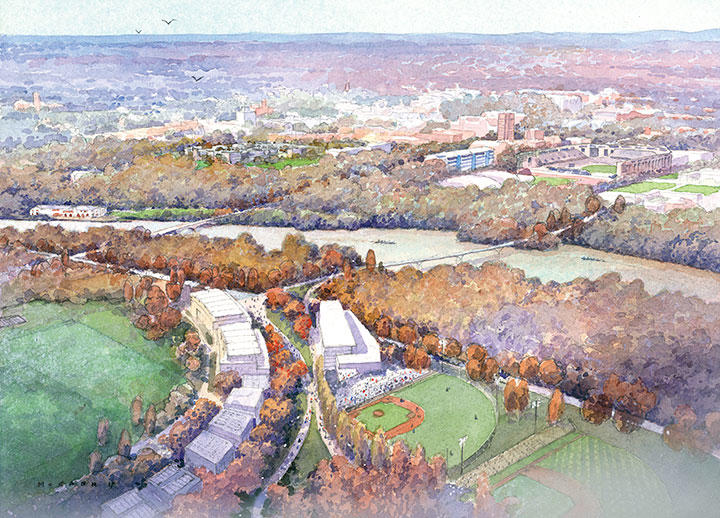Looking to the Future
Campus plan: A long list of possibilities for the next decade — and beyond
Creating a new campus south of Lake Carnegie, providing new housing for undergraduate and graduate students, and building new homes for engineering and the environmental sciences are among the recommendations in the University’s new campus plan.
The plan — released Dec. 5 — provides a framework to guide the development of Princeton’s physical campus within the next 10 years in “the context of potential needs and developments over the next 30 years,” the University said. (A summary of the plan will be mailed with the Feb. 7 issue of PAW.)
While the plan suggests possible locations and ideas for campus development, it does not determine whether or when Princeton will proceed with the projects. The University is currently developing a capital plan and a financial campaign that would support the projects.
Last April, the University announced that it was considering a site south of Poe and Pardee fields as the location for one or two residential colleges, with the goal of increasing undergraduate enrollment by 10 percent. Princeton also said it is considering an area along Ivy Lane and Western Way to replace the EQuad and expand engineering facilities, as well as to provide a new home for environmental studies and the departments of geosciences and ecology and evolutionary biology.
The campus plan reiterates those recommendations and describes other potential projects, including:
The development of a Lake Campus south of Lake Carnegie into a “lively and integrated campus community” with housing for up to 500 graduate students and postdocs, new facilities for softball and tennis, a transit hub, and buildings to house “academic partnerships in an innovation ecosystem.” Over time, the plan says, the Lake Campus might have a new hockey arena with two sheets of ice to replace Baker Rink.
The removal of some “outdated” Wilson College dormitories, which could be replaced by academic space or improved Wilson College facilities.
New uses for the EQuad, the Friend Center, the computer science building, and Guyot Hall once new facilities for engineering and environmental sciences are constructed.
Consideration of Green Hall as a “prime location for the humanities.”
Pedestrian and bicycle pathways through the campus — including one from Nassau Street to a proposed pedestrian bridge over Lake Carnegie and south to the Lake Campus.
Future use of the Springdale golf course for unspecified educational purposes. Springdale Golf Club’s lease with Princeton expires in 2036, but a provision allows the University to terminate it at the end of 2026.
An expansion of Dillon Gym and replacement of McCosh Infirmary with a new University Health Services building.
A number of sustainability features, including plans to encourage walking and cycling and discourage driving to the central campus.












2 Responses
Janko Rasic '59 *61
7 Years AgoA Better Campus Location
Since the founding of the University until today, a unique planning principle has prevailed. Campus walks allow students and faculty to reach destinations, whether class or dormitory, as pedestrians, within a 10-minute period. The proposed location of the new Lake Campus across Lake Carnegie (On the Campus, Jan. 10) is beyond reach of this pedestrian envelope.
With plans to accommodate as many as 500 graduate students, the Lake Campus could add substantially to traffic congestion on Washington and Alexander roads. Ecological considerations in building design will be offset by the added carbon footprint of road traffic.
As an alternative, the new campus can be centrally located on the Springdale Golf Course’s existing open space. This is well within walking distance of the entire University, and would allow development of new graduate-student housing adjoining the Graduate College. In exchange, the University can offer to build a new state-of-the-art golf course south of Lake Carnegie.
As it is, the Springdale course is no longer first-class. Land has been taken along the perimeter for faculty housing. The original clubhouse was taken down for a University building. The tees that had originally provided long vistas have become obstructive inclines. The pond and stream are not visible until after balls are lost.
The principle of a pedestrian university campus can be maintained!
Peter J. Turchi ’67 *70
7 Years AgoDeveloping a Lake Campus
With more than 50 years of watching my Class Notes migrate in from the back page, perhaps I would be permitted a few comments regarding the planning for University expansion (On the Campus, Jan. 10). The particular charm of a college campus may derive from its pedestrian nature, i.e., the campus should be walkable. While mass transit can convey students, faculty, and staff from outlying locations to the campus, it should be possible that once there, everything is reasonably accessible on foot. (I say this even with the Olympic-level race from 48 University Place to the EQuad.) Expansion of classroom space and undergraduate dorms close to Lake Carnegie and beyond would be a very substantial change in the nature of the Princeton experience, at least at the undergraduate level.
As an aero engineering student, I recall the successful use of Forrestal for graduate education (and some undergraduate labs). Later, traffic on Route 1 became too difficult for aero faculty to sustain interest in Forrestal for teaching and office space. The MAE department then moved almost completely to campus.
The land across Lake Carnegie can represent an opportunity to re-create the research park formerly a mile farther away at Forrestal, but without as much of a traffic problem. It could facilitate graduate education in science and engineering and might include conference and hotel space. The land could also be developed for graduate student (and junior staff) housing, addressing a critical issue for graduate-student life. All of this would not interfere with traditional Princeton campus life.